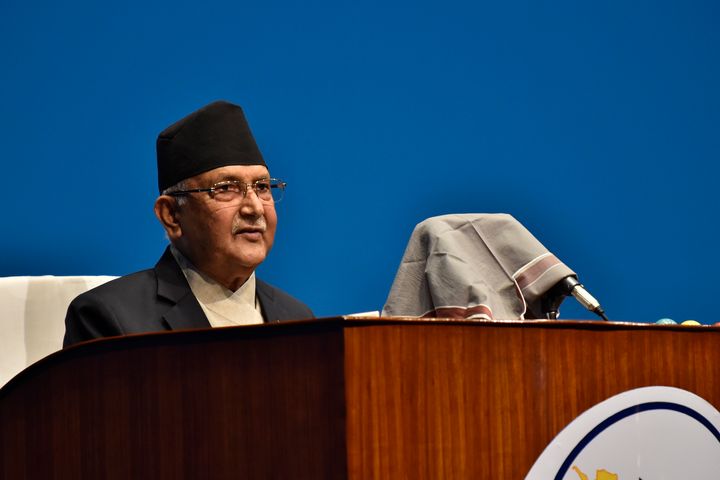
As India deals with the death of its soldiers in a “violent face-off” with China in eastern Ladakh, it’s also warily watching smaller neighbour Nepal, which is currently embroiled in two crises.
While Covid-19 cases in Nepal continue to rise amid people’s protests against the government’s response, the Himalayan country is moving ahead with a new map which shows Kalapani, Limpiyadhura and Lipulekh — areas also claimed by India — within its borders.
What’s the story behind the map?
Last week, Nepal’s lower house of Parliament unanimously passed the amendment that gives legal guarantee to the new map. It drew a sharp response from India, with MEA spokesperson Anurag Srivastava calling it “not tenable”.
“This artificial enlargement of claims is not based on historical fact or evidence and is not tenable. It is also violative of our current understanding to hold talks on outstanding boundary issues,” he said.
Nepal’s upper house of Parliament also unanimously passed the amendment on Thursday.
Former Indian Ambassador to Nepal Rakesh Sood had told HuffPost India earlier this month that if the country’s Parliament passes the constitutional amendment bill, it will make it more difficult to resolve matters, either now or in the future.
However,Madhu Raman Acharya, former foreign secretary of Nepal said that though the adoption of the map may seem to be posing a temporary setback, it will eventually help resolve the issue based on facts and treaties. He told HuffPost India that Nepal is still committed to resolving the matter through bilateral dialogue even if the map is adopted.
Nepal has been upset over a road inaugurated by Union Minister Rajnath Singh on 8 May which connects Dharchula and Lipulekh, according to reports.
However, the new road was not an unprecedented change in the status quo, Constantino Xavier wrote for Brookings. The road was not built overnight, he pointed out, adding that the Nepal government was aware and monitoring the situation in Kalapani.
Nepal had also protested in November 2019 when India released a new map to show the bifurcation of Jammu and Kashmir. New Delhi responded by saying that the map accurately depicted its sovereign territory and it has in no manner revised its boundary with Nepal.
“India’s new political map issued in November 2019 showed the ‘Kali River’ within its territory, whereas that is supposed to be a boundary river, disregarding the earlier stated position between the two Prime Ministers that the issue would be resolved bilaterally through talks at the Foreign Secretary level,” Acharya explained.
He added that Nepal reacted to the “unilateral action” after Singh inaugurated the road, disregarding Nepal’s request for talks. He, however, pointed out that Kathmandu has once again asked India to sit down for talks.
How’s the Covid-19 situation in Nepal?
Certain media reports have speculated that PM Oli was able to divert attention from his government’s handling of the Covid-19 crisis in Nepal by using the road inauguration and whipping up nationalist sentiments (see here and here).
Others disagree. Citing the all-party consensus on the map, Kamal Dev Bhattarai, a Kathmandu-based journalist, told HuffPost India that the new map may have helped PM Oli strengthen his position in the party and government but it is not right to say that the issue was taken up to divert attention from the government’s handling of Covid-19.
The voting in Nepal’s lower house showed that members from all the political parties voted in favour of the motion, The Hindu said. The amendment got support not just from the ruling Nepal Communist Party, but also the Nepali Congress and Janata Samajvadi Party-Nepal, it added.
Acharya also said the new map has nothing to do with the Covid-19 situation, “except that India chose to inaugurate the border road in the territory in the midst of the pandemic, but refused to sit down with Nepal for talks citing the same”.
There are a total of 6,211 cases of Covid-19 in Nepal, according to data compiled by Johns Hopkins University, and 19 deaths. While Kathmandu has been asking for dialogue, New Delhi has said it will talk once the coronavirus crisis is over.
There have been reports of protests in Nepal over the government’s response to the coronavirus crisis. 10 people, including seven foreigners, were arrested on Saturday during demonstrations in Kathmandu.
For the latest news and more, follow HuffPost India on Twitter, Facebook, and subscribe to our newsletter.
“The foreigners were arrested for interfering in Nepal’s internal affairs,” police official Basant Lama told Reuters.
The report said that protesters have been demanding better quarantine facilities, more tests and transparency in the purchase of medical supplies to fight the crisis.
Even as his government continues to face criticism over its response to Covid-19, Oli has reportedly decided not to accept medical teams from India or China, The Hindu reported.
“Nepal is happy to welcome medical materials from our friends,” Bishnu Rijal, Deputy Chief of the NCP’s Foreign Affairs department, was quoted as saying in the report, adding that Nepal’s health professionals were capable of handling the pandemic.
When asked if Nepal’s decision could have been because of the border dispute, Bhattarai said the two are not related. “Till now, Covid-19 is under control and government is of the view that domestic health professionals can handle the situation,” he said.